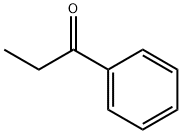Description
Propiophenone belongs to the family of acetophenones, which is present in some certain cheese, coffee and coffee products, tea and roasted nuts with sweet-smelling odor. It is wisely used as an intermediate in the preparation of other organic compounds, such as synthetic aryl alkenes, like cinnamic acids. It is also a useful intermediate for pharmaceuticals production, such as ephedrine, propiophenone derivatives (cathinone and methcathinone), and especially for the preparation of nervous system drugs (anxiolytic and hypnotic drugs). Besides, due to its naturally pleasant flowery odor, propiophenone can be used as a component in some perfumes.
References
https://en.wikipedia.org/wiki/Propiophenone
https://pubchem.ncbi.nlm.nih.gov/compound/7148#section=Top
http://www.chemicalland21.com/industrialchem/organic/PROPIOPHENONE.htm
https://www.alfa.com/en/catalog/A15140/
Chemical Properties
Propiophenone has a strong, flowery odor. 1-Phenyl-1-propanone is a colorless liquid with a flowery odor, insoluble in water, readily soluble in organic solvents. Typical reactions can be carried out at the methylene group, the carbonyl group, and at the aromatic nucleus.
Occurrence
Reported found in coffee, roasted filberts, roasted peanuts and roasted green tea. Also reported found in
Camembert cheese, black tea, roasted macadamia nut, tamarind, dried bonito, cherimoya and sapodilla fruit.
Uses
1-Phenyl-1-propanone is used mainly
as an intermediate for pharmaceuticals such as DPropoxyphen, phenylpropanolamine, and
Phenmetrazine.
Uses
Propiophenone is an aryl ketone used in the preparation of pharmaceutical and organic compounds. Propiophenone is used in perfumes as well as in the preparation of neurochemical compounds such as ephe
drines.
Uses
In perfumery; in the synthesis of ephedrine and related Compounds.
Definition
ChEBI: Propiophenone is an aromatic ketone in which the two substituents on the carbonyl C atom are phenyl and ethyl. It has a role as a fragrance.
Production Methods
Propiophenone is produced by the Friedel–Crafts acylation
of benzene with propionic acid chloride in the presence of
aluminum chloride. It may also be produced by the reaction
of benzoic acid and propionic acid using a calcium acetate–
aluminum oxide catalyst.
Flammability and Explosibility
Not classified
Safety Profile
Poison by
intraperitoneal route. Moderately toxic by
subcutaneous route. Mildly toxic by
ingestion and skin contact. A skin and eye
irritant. A flammable liquid when exposed to
heat or flame; can react with oxidizing
materials. To fight fire, use foam, CO2, dry
chemical. When heated to decomposition it emits acrid smoke and irritating fumes. See
also KETONES.

